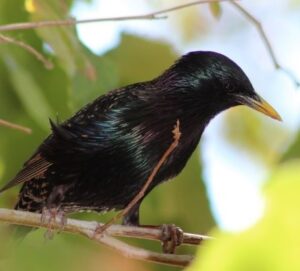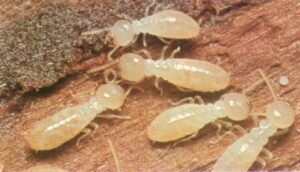Our Control Strategy Get Rid of Stored Product Pests
Introduction
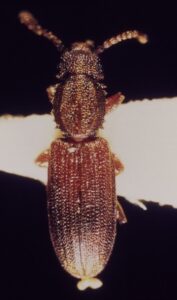
Stored product pests are usually found living in products (such as dried fruits, spices, flour, bran, peas, dried vegetables, dried flowers, grain, milled cereal products, dog food, nuts, candy, pasta, cheese, and other similar items) and are considered the most severe pests that share food with humans. They cause great losses on grain and stored foodstuffs. Stored products are exposed to a number of harmful insects during their storage period, after harvest, when they are collected after harvest, or while they are in the field. Losses resulting from insect damage to stored grain are estimated at 5–7% annually (and may reach 15%). Most pests of stored grains belong to the order Coleoptera, except for butterflies, which belong to the order Lepidoptera.
Stored food pests cause much damage.
- by consuming or borrowing a large part of the foodstuffs, and the weight of grains may decrease to half of their original weight.
- decreased food quality and nutritional value. Infestation with pests affects the appearance, smell, and taste of foodstuffs, insect excrements accumulate among the stored grains.
- Low economic returns and non-acceptance of foodstuffs commercially.
- Infestation with pests may cause subsequent infestations with other pests and microorganisms that increase damage and losses.
- damage to grain containers and loss of quality.
- low germination rate of grains in the case of reusing them as seeds.
Stored product pest control professional and managers of warehouse facilities should know that:
- Infestation of homes with pests of stored foodstuffs is due to human behavior in keeping various types of foods in his house, the method of preserving and caring for them, and the rate of consumption.
- The amount of damage caused by pests varies according to the density of the pest, the value of the food and the type of damage, whether by consuming the food or transmitting a pathogen to humans or animals.
- Stored food pests usually enter homes hidden in food packagings such as bags and boxes, or are transmitted from infected food that was accidentally brought home. And when they find the right environment and conditions, they increase in number and attack uninfected food.
- Stored foodstuffs (cereals, dry foods, and their products) are infested with a large number of pests of more than 200 species. Including what affects healthy or previously infected grains, what feeds on dry fruits or vegetables and nuts, and what affects processed products such as cheese, chocolate, candy, and meat.
- Some pests are specialized for one type of material and others attack many types of food (they are considered general feeders such as ants, cockroaches, flies, rodents, silverfish, and some types of booklice).
- It is necessary to indicate the type of pest harmful to foodstuffs so that appropriate protection or control measures can be taken.
- There are several systems for defining food pests, some of which depend on the ranks and species that follow them, while others depend on the damage they cause or the food families that affect them.
The most common stored product pests are:
I – Internal Feeders:
Internal feeders are insect larvae that feed entirely within the kernels of whole grain and palletized product, and thus may remain undetected until adults emerge from the kernels. The most common species are:
- Angoumois Grain Moth – Sitotroga cerealella Oliv) (Gelechiidae: Lepidoptera
- Granary Weevil or Wheat Weevil – Sitophilus (= Calandra) granarium (Curculionidae: Coleoptera)
- Rice Weevil – Sitophilus oryzae (Curculiondae: Coleoptera)
- Lesser Grain Borer – Rhizopertha dominica (Bostrichidae: Coleoptera)
II – External Feeders:
External feeders feed on the outside of the grain. They may also chew through the outer seed coat and devour the inside. The most common species are:
- Indianmeal Moth – Plodia interunctella (Hübner) (Pyralidae: Lepidoptera(
- Cigarette Beetle – Lasioderma serricome (Fabricius) (Anobiidae: Coleoptera)
- Cadelle Beetle – Tenebroides maurilanicus (L.) (Tenebrionidae: Coleoptera)
- Khapra Beetle or Trogoderma – Trogoderma granarium (Everts) (Dermestidae: Coleoptera)
- Drugstore Beetle – Stegobium paniceum (Linnaeus) (Anobiidae: Coleoptera)
III- Scavengers:
Scavengers feed on grain only after the seed coat has been broken, either mechanically or by some other insect. The most common species are:
- Mediterranean Flour Moth – Ephestia (Cadra) kuehniella Zeller (Pyralidae: Lepidoptera)
- Confused Flour Beetle – Tribolium confusum (Jacquelin du Val) (Tenebrionidae: Coleoptera)
- Red Flour Beetle – Tribolium castaneum Herbst (Tenebrionidae: Coleoptera)
- Sawtoothed Grain Beetle – Oryzaephilus surinamensis Linnaeus (Cucujidae: Coleoptera)
IV – Secondary Pests:
Secondary pests feed only on materials that are deteriorating, damp, and have some mold growth present. Some of them feed on mold rather than the food product. The most common species are:
- Yellow Mealworm – Tenebrio molitor (Linnaeus) (Tenebrionidae: Coleoptera)
- Dark Mealworm – Tenebrio obscurus (Tenebrionidae: Coleoptera)
V – Rodents (please link to rodent section)
Click on each pest species to learn about its general description, life cycle, common characteristics, and its damage and economic implications.
I – Internal Feeders:
- Angoumois Grain Moth
General Description
- The adult is 5-7 mm yellow-brown. The forewings are narrow, pointed at both ends, and have black dots. The hind wings are gray and end in the shape of a finger.
- The larva is 5-7 mm long, cylindrical, red at hatching, and white when fully developed.
- The pupa is red or light brown.


- Life Cycle and Common Characteristics
- The overwintering occurs at the caterpillar stage in cold regions (there is no overwintering in warm regions).
- Females lay eggs on grains individually or in groups between rows of corn or in cracks of wheat or barley grains or on wheat spikes in fields with a reddish-white color.
- The female lays 40-390 eggs.
- Incubation of eggs from 3-10 days in summer and 20-30 days in winter.
- The larva feeds on the contents of the bean and weaves silk threads, infecting the bean with one larva.
- There are 3 ages for the caterpillar (20-24 days).
- Pupa stage takes about 9-12 days.
- The adult insect lives 12 days in the summer and 28 days in the winter.
- The generation period is 5 weeks in the summer and 9-10 weeks in the winter.
- There are 5-6 generations per year
Damage and Economic

- It is frequently found on infected grains, and it is fast flying and moving insect.
- The larvae feed on the starchy materials inside the grain and weave silk threads around it, and the corn grain may lose 15-25% of its weight during the feeding of the larvae, and therefore they cause huge losses to the grain in the store. Also, the germination strength of the grain decreases and the value of flour decreases due to the abundance of feces and other insect parts.
- The grain is infested by one caterpillar (i.e., significant economic damage).
-
- Khapra Beetles or Trogoderma
- Indianmeal Moth Granary Weevil or Wheat WeevilGeneral Description
· The adult length is 3-4 mm. · The adult cannot fly. There are elongated dents on the anterior pronotum.
· The color of the adult is dark chestnut or black closely resembles the rice weevil
· The larva is 3 mm long, legless, and arched. The head is red-brown and the body is white.
· The pupa is white with her head down.

Life Cycle and Common Characteristics
- There is no hibernation.
- The insect lives 10 months.
- The female lays eggs (total of 200-300 eggs) individually in small holes that the female makes through her mouth in the grain, and then covers with a slimy substance.
- The larva feeds on the contents of the grain, and after completing its growth, it makes a cocoon inside the grain from the particles of the infected grain, and it pupates.
- The adult emerges from a hole in the bean.
- The insect does not develop in grains if the moisture content is less than 10%.
- The generation is about one month in the summer and longer than that in the winter.
- Notes: In areas with high temperatures, the incidence of granary or wheat weevil decreases and the incidence of rice weevil increases.
Damage and Economic Implications
- The larva and the adult insect feed on the stored grain (wheat, rice), dried fruits, grain products, and tobacco leaves.
- Lesser Grain BorerOne grain infested with one caterpillar.
- Rice Weevil
General Description
· The adult is 3-5.3 mm in length, dark brown, with four yellow spots on the forewings. the body is narrow and elongated and the front of the head extends like a beak. The hind wings are present. The adult is able to fly. · Larva and pupae: similar to the granary weevil.

Credit: Udo Schmidt
Life Cycle and Common Characteristics
- Similar to the granary weevil.
Damage and Economic Implications
- The damage of the rice weevil is more than the granary or wheat weevil because it has the ability to fly.
- It infests grain (rice, wheat, barley, and corn) in the field before harvesting.
- It multiplies rapidly in the summer.
- The larva and the adult insect feed on the stored grains, destroying them and making them vulnerable to other insects.
- Lesser Grain Borer
General Description
· It is distinguished from the rest of the grain insects by its cylindrical shape and small size, as the adult is 2.5 mm long. The body is rough, dark chestnut or glossy black, and there are concave spots on the forewings arranged in the form of lines. The head is curved downwards and is equipped with powerful jaws that enable it to pierce wood and grain. · The larva is 2.5-4 mm in length, and white. It is thick-bodied, cylindrical, and grub-like. The head is brown and arched and the legs are small.
· The pupa is whitish in color (it looks like an adult).

Credit: CSIRO
Damage and Economic Implications
· The larva and the adult insect feed on the stored grain and products (wheat, barley, corn, rice, pasta). · The adult digs into the dried grains.
· The larvae feed on the grains after being infested or feed on the damaged grains or products.
 Credit: Clemson University – Bugwood.org
Credit: Clemson University – Bugwood.orgIiI- External Feeders:
- Lesser Grain BorerOne grain infested with one caterpillar.
General Description
- The adult is 7-10 mm long, the basal third of the forewings are gray and the remaining section is reddish-copper. Hind wings are gray with dense pubescence.
- The larva is 10-17 mm long, white (yellowish-greenish-reddish), pinkish-white, and has brown spots on its body.
- The pupa is brown and 11 mm long.
 Credit: Mvuijlst
Credit: Mvuijlst Credit: Pudding4brains
Credit: Pudding4brainsLife Cycle and Common Characteristics
- The larva overwinters inside the stored products.
- Females lay eggs (350 eggs in total) in groups on stored products or beside food.
- The eggs hatch after a few days, and the egg incubation for 3-12 days.
- The larva needs 4-6 weeks to complete its development in the summer and 20 weeks during the winter.
- The fully developed larva weaves a silken cocoon, which turns into pupae inside.
- The pupa phase is 26 days (16°C) or 4 days (31°C).
- The generation period is 3-7 weeks in warm regions.
- The larvae of the last generation, at the end of autumn, hibernate.
- There are 6-7 generations per year.
Damage and Economic Implications
- The larva feeds on the stored materials (flour, yellow corn, dried fruits, biscuits, chocolate, dried milk dates) and secretes silky threads surrounded by the materials it fed on.
- The larva pollutes the feeding site with feces and renders the materials unsuitable for consumption.
Life Cycle and Common Characteristics
- The larva overwinters inside the stored products.
- Females lay eggs (350 eggs in total) in groups on stored products or beside food.
- The eggs hatch after a few days, and the egg incubation for 3-12 days.
- The larva needs 4-6 weeks to complete its development in the summer and 20 weeks during the winter.
- The fully developed larva weaves a silken cocoon, which turns into pupae inside.
- The pupa phase is 26 days (16°C) or 4 days (31°C).
- The generation period is 3-7 weeks in warm regions.
- The larvae of the last generation, at the end of autumn, hibernate.
- There are 6-7 generations per year.
Damage and Economic Implications
- The larva feeds on the stored materials (flour, yellow corn, dried fruits, biscuits, chocolate, dried milk dates) and secretes silky threads surrounded by the materials it fed on.
- The larva pollutes the feeding site with feces and renders the materials unsuitable for consumption.
- Cigarette Beetle
General Description
· Adult cigarette beetles are light brown, about 3 mm long, and fly readily. The head is bent downward, so the beetle has a distinct hump-backed appearance.
· The larva resembles the drugstore beetle larva, but the body hairs of the cigarette beetle are considerably longer, giving it a more fuzzy appearance.
 Credit: Udo Schmidt
Credit: Udo SchmidtLife Cycle and Common Characteristics
- The female lays about 30 eggs over a period of about three weeks in newly harvested tobacco or other susceptible food items.
- The adults are most active during the early evening hours- unless temperatures are below 18.3°C, which causes them to stay closer to their harborage areas.
- Adults hide during the day in dark places. Even though they are strong fliers, their primary means of spreading is via infested materials transported by humans.
Damage and Economic Implications
- The cigarette beetle is the most important pest of stored tobacco. It may also be a serious pest of items such as books, flax tow, cottonseed meal, rice, ginger, pepper, paprika, dried fish, crude drugs, seeds, pyrethrum powder, and dried plants.
- Larvae feed on dried tobacco leaves, causing great damage.
- The color is nearly white throughout, except for a distinctive group of yellowish-brown markings on the front surface of the head. The lower margin of the head is colored, and a series of four spots are arranged just above this area in such a way that a pattern suggestive of a little clown-like face is formed.
- Cadelle
General Description
· The adult is black, about 8-12 mm long. The body is oblong and tends to be an oval in shape. It has strong jaws, and its head and thorax are connected to the abdomen by a small ring. · The larva is relatively large in size and may reach a length of 18 mm. The color of the larva is yellowish-white, and the abdomen ends with two strong thorns, dark brown or black in color.
 Credit: Rosa Henderson
Credit: Rosa HendersonLife Cycle and Common Characteristics
- The insect spends its winter hibernation in the larval stage or an adult.
- The female lays eggs in groups on or near food items (from 10-60 eggs per group).
- One female can lay about 1000 eggs.
- The eggs hatch after 7-10 days on average into larvae that complete their development in a period ranging from 2-14 months,
- The larva may live for 3.5 years before turning into a pupa.
- It is considered one of the longest-lived food insects, as the average life reaches about a full year and may extend to two years. They can survive for a long time without food.
- An insect has one generation per year.
Damage and Economic Implications
- This insect infests flour, crushed grains, and cereal products.
- It is sometimes considered one of the most dangerous insects of stored grains, and if it is abundant, its damage becomes severe, especially in mills.
- It has the ability to puncture food packaging bags and cartons.
The larva has a habit of burrowing into the wood and is difficult to remove when performing normal cleaning operations. It prefers to feed in the embryo area on whole grains and can feed on other insects.
- Indianmeal Moth Granary Weevil or Wheat WeevilGeneral Description
General Description
· The adult is 1.6 -1.8 mm long. The body is brown, and the chest is reddish-brown. The body is covered with soft fluff and this allows it to glide between the grains. The antennae are yellow, and consisting of 10 segments. · The small, fast-moving larva is orange-yellow, with a brown halo on the last three abdominal rings. It is 3 mm long. The body is covered by long hair.
· The pupa is a larva-like structure and remains within the last larval skin.
 Credit: USDA
Credit: USDALife Cycle and Common Characteristics
- The female lays 35-126 eggs between the cracks of the grain without giving them a glue substance, as in other insects, and lays them individually, or puts them in the cracks of the walls of the stores.
- Incubation of eggs from 5-12 days in the summer.
- The growth of the larva is completed within 20 days at 40°C and 40 days at 25°C.
- The larva overwinters in the cracks in the walls.
- The larva molts 4-14 times (depending on the amount of food).
- The larva has the ability to live for a year without food.
- The larvae enter dormancy in the cracks of the walls of the storage area, and this depends on the exposure of larvae to low temperatures and their exposure to high or low humidity.
- All stages are resistant to heat and drought and can withstand a temperature of 45°C.
- The larva can live in a relative humidity of less than 2%.
- The larva lives in empty warehouses for 4 years without food.
- There are 10 generations per year, one generation per year, or one generation over a year (depending on the environmental conditions).
Damage and Economic Implications
- They live on grain products such as flour, groats, pasta, and biscuits. They multiply on castor seeds and cotton. A type of them has been found that lives on all animal products, especially wool.
- The larva and the adult insect feed on wheat and corn grains, destroying and polluting the grains.
- Drugstore Beetle
General Description
· The adult is small in size, no more than 3 mm in length. It is reddish-brown in color and covered with short yellow hairs. · The larva is white in color and reaches a length of 5 mm when fully grown. On its arched body, there are short, translucent bristles.
 Credit: Siga
Credit: SigaLife Cycle and Common Characteristics
- The female lays eggs individually in cracks in the surrounding products.
- The time required for the transition from the egg to the full insect varies greatly depending on the prevailing temperature. In warm weather conditions, the development of the stages takes place within one month, while in cold weather it takes a whole year.
Damage and Economic Implications
- It feeds on many food products (food products such as bread, flour, spices, leather products, books, and carton packages). It may pierce sheets made of tin and lead, and is characterized by digging in a straight line in those materials.
- The larva is the only feeding stage and can survive several weeks without feeding.
- The insect has the ability to infest toxic substances such as poisoned pills and medicines.
- Some specialists call this pest “the pest that eats everything but iron.”
III – Scavengers:
- Mediterranean Flour Moth
General Description
· The adult is about 1 cm long. The distance between the two ends of the flat front wings is 2.5 cm. The color of the forewings is light gray, each with two brown stripes. The hindwings are white with gray flanks and long fringes on the forewings and hindwings. · The larva is pale yellow or pink in color. On the body, there are small black tubercles, from which long hair appears, and the color of the head is dark brown. When fully grown, it is about 1.5 cm.
· The egg is oval in shape, and white in color, and on its shell from the outside are simple protrusions resembling adjacent circles.
 Credit: Andy Reago & Chrissy McClarren
Credit: Andy Reago & Chrissy McClarrenLife Cycle and Common Characteristics
- The female lays eggs individually in accumulations of flour or other milled products.
- The female lays about 200-300 eggs. The eggs hatch after about a week into larvae that begin weaving threads, starting at the third larval stage.
- The duration of the larval stage is from 4-6 weeks. Before turning into a pupal stage, the color of the larva becomes dark green.
- The pupal stage is from 8-14 days.
- The duration of the generation is 7-18 weeks, and it has 3 generations per year.
Damage and Economic Implications
- The larvae feed on dried fruits and pollen in beehives. They are found in grain and its products. They can adapt and reproduce at 1% relative humidity.
- The larvae make tunnels in the foodstuffs that infect them and secrete thick silky threads on them that stick the particles of the food together and turn them into adjacent masses that are difficult to remove or clean.
- Confused Flour Beetle
General Description
· The adult is 3-4 mm long and 1-1.2 mm wide. Oval in shape. Its color is reddish brown. · Egg: very small, flattened, oval ,and white in color.
· The larva is white-tinged with yellow, and the upper surface of the body segments is dark in color and covered with yellow hairs. The larva is cylindrical in body shape. The fully developed larva is about 6.5 mm long.
· The pupa is white tending to yellow. It is about 4 mm long.
 Credit: Sarefo
Credit: SarefoLife Cycle and Common Characteristics
- The female lays 350-450 eggs on stored foodstuffs during her lifetime.
- The incubation period for eggs ranges from 5-25 days, depending on the temperature.
- The duration of the larval stage is 33 days.
- The duration of the pupal stage is from 6-20 days.
- The adult insect lives from 170-200 days.
- The insect has 4-5 overlapping generations per year.
Damage and Economic Implications
- The insects is found on stored foodstuffs such as wheat, wheat, and corn flour, as well as dates that are packed in warehouses.
- It does not cause economic damage.
- Red Flour Beetle
General Description
· The adult is 3-3.7 mm long and 0.9-1.2 mm wide. · This insect resembles a flour beetle that is similar or confusing in appearance and color but differs in that the last three or terminal segments of the antennae are enlarged and enlarged suddenly from the previous ones so that the antennae look like a club.
· The egg is cylindrical in shape and white in color.
· The larva is white with a yellowish tint. When fully grown, they are about 6.5 mm long. The larva is cylindrical in shape, its pectoral legs are growing, and the abdomen ends with two short spines (anal horns) that are brown in color.
· The pupa is naked and lives in the same environment as the larva.
 Credit: Udo Schmidt
Credit: Udo SchmidtLife Cycle and Common Characteristics
- The female lays 400-500 eggs on stored foodstuffs during her lifetime.
- The eggs hatch after 3-32 days.
- The incubation period for eggs ranges from 10-25 days, depending on the temperature.
- The larva goes through six larval instars (up to 12, depending on the type of food).
- The duration of the larval stage is from 33-100 days.
- The pupal stage lasts from 5-18 days.
- The adult insect lives from 170-200 days (and may live from 1-1.5 years sometimes).
- The insect has 4-5 overlapping generations per year.
Damage and Economic Implications
- The insect infests stored dates, flour, grains, dried fruits, nuts, and other stored foodstuffs.
- It does not cause economic damage.
- Sawtoothed Grain Beetle
General Description
· The adult is 3 mm long and 1 mm wide. There are six waw-like projections on each side of the thorax. · The adult is unable to fly.
· The larva is 4-5 mm long, narrow in body form, and it is yellowish white. Each of its abdominal segments bears a yellowish plate on the top side.
· Pupa is 4 mm long, yellow with toothy protrusions on the edges of the body.
 Credit: Udo Schmidt
Credit: Udo SchmidtLife Cycle and Common Characteristics
- The adult spends the winter hibernation on the stored products or in the cracks of the walls of the stores.
- The female lays eggs (total 45-285 shiny eggs) in small masses in crevices in the food supply, although they are also laid freely in flour.
- The female does not lay eggs below 24°C (the optimum is 30°C).
- Egg incubation is 5-15 days.
- The larva feeds on stored products and molts 2-4 times.
- The larva is fully developed from 2-10 weeks.
- The larva pupates and the pupal stage takes about 1-2 weeks.
- The generation period is 3-4 weeks.
- The insect has several generations a year.
Damage and Economic Implications
- The larva and the adult insect feed on stored and crushed grain and flour (flour, pasta, chocolate, tobacco, hazelnuts, pistachios).
- The larvae damage the products and pollute them with their waste.
IV – Secondary Pests:
- Yellow Mealworm
General Description
· Adults of the yellow mealworm are shiny dark brown or black, about 1.25 cm long. · When the larva is fully grown, it is a little over 2.5 cm. The body is elongated and cylindrical, and has a harder body wall than the larvae of most other stored product pests. The body has a shiny yellow or light brown appearance, with only a few scattered setae.
 Credit: Udo Schmidt
Credit: Udo SchmidtLife Cycle and Common Characteristics
- Mealworms (adults and larvae) are usually found in dark, damp places in spoiled grain products. In residences, they are common in basements or at soil grade level.
- Mealworm adults are slow-moving insects.
- Adult mealworms live only about 10 weeks.
- Each female lays about 275 eggs, which hatch into larvae that grow to 2.25 cm long.
- The insect may remain in the larval stage for up to 600 days, depending on temperatures.
Damage and Economic Implications
- Larvae are active and are found in all sorts of unusual places in addition to breakfast cereals, macaroni, and feed mills.
- Dark Mealworm
General Description
· Adult dark mealworms are the same size as yellow mealworms but are dull black. Larvae are dark brown, as compared to the shiny yellow to light brown yellow mealworm.  Credit: NobbiP
Credit: NobbiPLife Cycle and Common Characteristics
- The dark mealworm has a similar life cycle and habits to the yellow mealworm.
Damage and Economic Implications
- The dark mealworm causes similar damage caused by the yellow mealworm.
V – Rodents (please link to rodent section)
- Khapra Beetles or Trogoderma



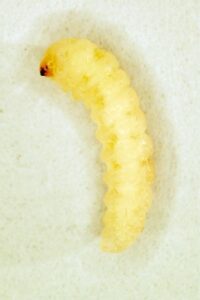
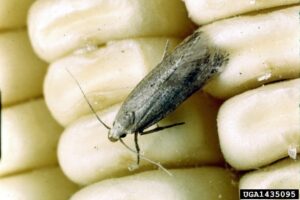

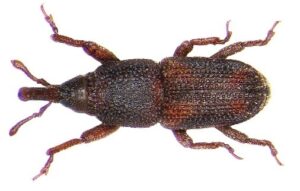

 Credit: Clemson University – Bugwood.org
Credit: Clemson University – Bugwood.org Credit:
Credit: 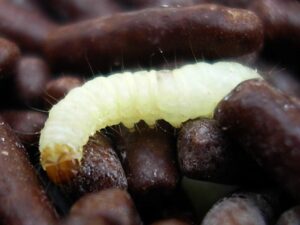 Credit:
Credit: 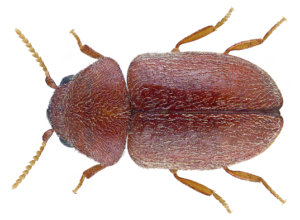 Credit: Udo Schmidt
Credit: Udo Schmidt Credit: Rosa Henderson
Credit: Rosa Henderson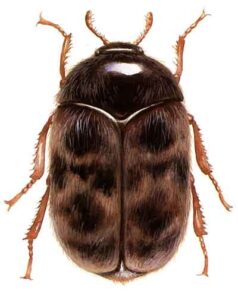 Credit: USDA
Credit: USDA Credit: Siga
Credit: Siga Credit:
Credit: 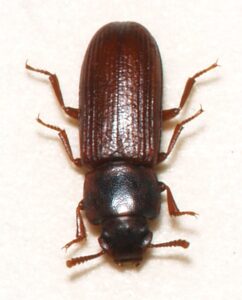 Credit: Sarefo
Credit: Sarefo Credit: Udo Schmidt
Credit: Udo Schmidt Credit: Udo Schmidt
Credit: Udo Schmidt Credit: Udo Schmidt
Credit: Udo Schmidt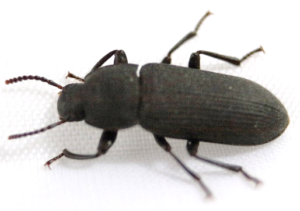 Credit:
Credit: 